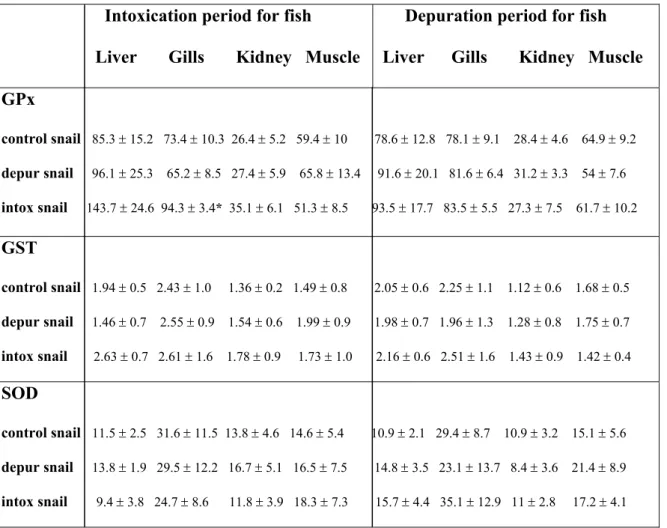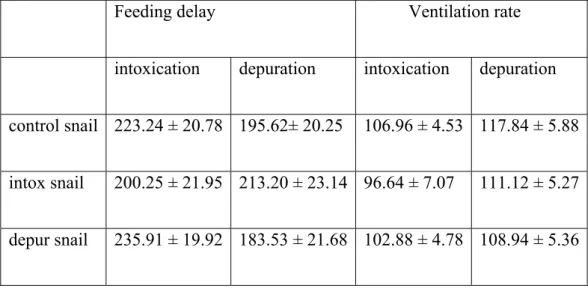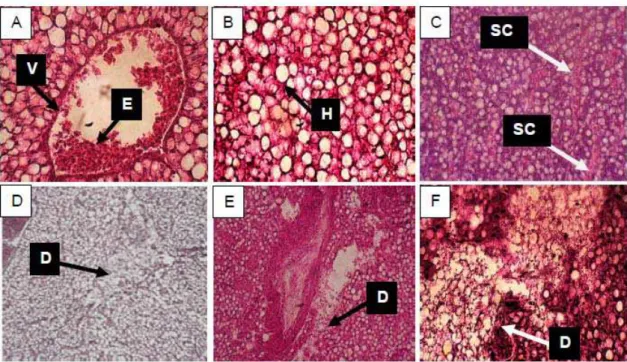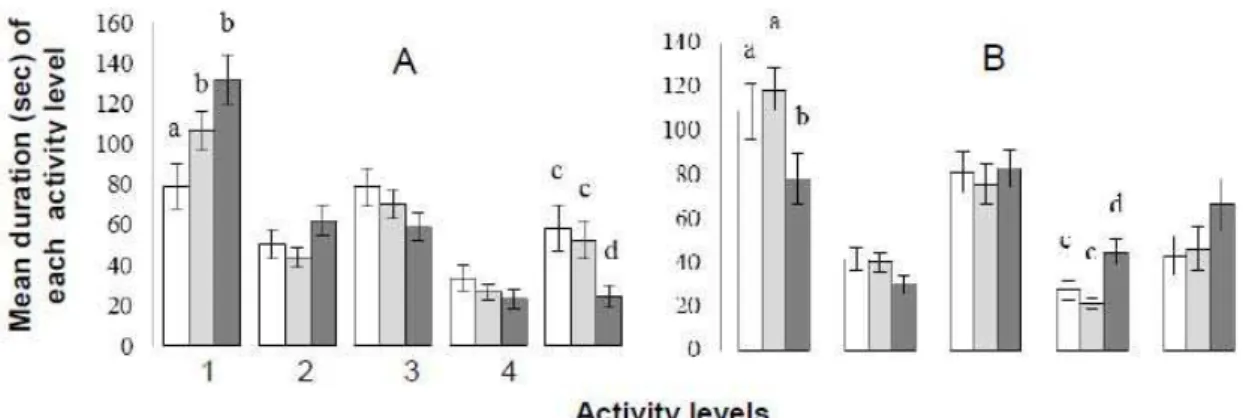Once present in organisms, MCs target the liver (vertebrates) or digestive gland (invertebrates), where they specifically interact with protein phosphatases (PPases) essential for cellular integrity (Zurawell et al., 2005). PPase inhibition first occurs through a rapid and reversible hydrophobic binding, leading to the accumulation of free MCs that can be eliminated by detoxification processes (Wiegand et al., 1999). This step is followed by a covalent binding to proteins, leading to the accumulation of MCs irreversibly bound to animal tissues - bound MCs - (Hastie et al., 2005).
These covalently bound MCs can be made bioavailable in the digestive system of a consumer through the digestion of their attached protein phosphatase, thus forming a reservoir of potential toxicity for consumers (Smith et al., 2010). Due to their herbivorous feeding habits (Dillon, 2000), they are primarily intoxicated by toxic cyanobacteria ingestion compared to exposure to dissolved toxins (Gérard and Poullain, 2005; Lance et al., 2010b). This produced three MC variants: dmMC-LR, dmMC-RR and MC-YR as demonstrated in Lance et al.
The method used detects total (bound plus free) MC content in cochlear tissue (10 mg digestive gland) through the formation of 2-methyl-3-methoxy-4-phenylbutyric acid (MMPB) as an oxidation product of the MCs, and detection of MMPB by liquid chromatography electrospray ionization tandem mass spectrometry (LC-ESI-MS/MS) (Lance et al., 2010a; . Neffling et al., 2010). Analysis by immunoassay was realized as described in Lance et al. 2006) with an ELISA Microcystin Plate Kit (Envirologix INC), which detects the three MC variants (dmMC-LR, -RR and MC-YR) produced by P. SOD, and the total GPx activities were assessed according to to the methods of Paoletti et al. . 1986) and Paglia and Valentine (1967) using NADPH as substrate and purified bovine enzymes (Sigma) as standards, respectively.
For the determination of GST activity, chlorodinitrobenzene was used as a substrate (Habig et al., 1974) and GST was purified from horse liver (Sigma) as a standard.
Statistical analysis
All assays were adapted for the three-spined stickleback as described by Sanchez et al. 2005) and kinetic measurements were performed in microtiter plates for 5 min, using a microplate reader (Power Wavex – Bio-Tek instruments).
Results
- MC accumulation in gastropods and fish
- Histopathology of fish liver
- Biotransformation and oxidative stress enzymes
- Behavioural observations and gill ventilation rate 1. Feeding delay and gill ventilation rate
Differences in MC accumulation and excretion were observed according to diet (concentrations of free and covalent MC) and organ (liver, gills, kidney and muscle). Indeed, there was an elimination of MC from fish tissues, as the MC content was lower than 1 µg g-1 DW at the end of the purification period, regardless of the organ. Interestingly, the MC content was similar between the two periods in the livers of fish from
In the gills, MCs were completely eliminated at the end of the depuration period for both groups. In the liver of control mice, the parenchymal architecture was regular, consisting of hepatocytes forming a cell array (Fig. 2B). The liver of intoxicated fish was globally similar to that of controls, but showed little disintegration of the parenchymal architecture located near the blood vessel for both the "intoxicated snail" (Fig. 2D) and "drunk snail" (Fig. 2EF) groups ).
Induction of GPx activity was observed in fish liver, but no statistical tests were performed on the data (n=2). During the intoxication period, the total duration of immobility was significantly different between groups (KW: H = 12.11; ddl = 2; p < 0.05). Sticklebacks significantly decreased their immobility time and increased their slow, medium, and fast mobility time during depuration (T = 1016 and p < 0.05, respectively).
Discussion
The transfer of MC-intoxicated zooplankton (e.g. Artemia salina larvae) to fish (e.g. Lepomis gibbosus, Cyprinus carpio) reported for free MCs under controlled conditions resulted in a lower MC accumulation (up to 11.2 ng g DW in the liver) than in our study (Smith and Haney, 2006; El Ghazali et al.; 2010). Since MCs accumulated in a covalently bound form in the prey can be made bioavailable in the digestive system of the consumer by their attached protein phosphatase (Smith et al., 2010), it should be taken into account to reduce the cyanotoxin risk in the environment . The percentage presented above is underestimated because it only includes MCs in the liver of G.
However, MCs also accumulated in other organs as we demonstrated, and the total MC content in the fish was not assessed. Furthermore, since the bound MCs in the fish were not evaluated, the total amount of MCs accumulated may be better than the total amount of free MCs ingested. We attempted to evaluate bound MC accumulation in the three-spined stickleback tissues by two methods, Lemieux oxidation with mass spectrometry and immuno-histochemistry.
Ibelings et al., 2005; Papadimitriadou et al., 2012) have demonstrated the transfer of MC without biological magnification in the food web of water bodies exposed to toxic blooms by evaluating the free content of MC at successive trophic levels (phyto- and zoo-plankton, bivalves, gastropods, lobsters, fish, and frogs). However, it may depend on the fish species as Lehman et al. 2010) demonstrated a biomagnification with a higher bioaccumulation in striped bass than in its prey in San Francisco Bay exposed to M. No induction of GST activity was demonstrated in our study, but we show an induction of the activity of GPx in the liver and gills of G intoxicated by MC.
In the field, liver damage also occurred for 37% of perch and roach exposed to MC-intoxicated zooplankton and bivalves (Ibelings et al., 2005). Moreover, increased ventilation has been shown to indicate a physiological stress in the whitefish following the ingestion of MC-producing P. 2008) respectively reported that sunfish and threespine sticklebacks consumed MC- and nodularin-intoxicated zooplankton in the laboratory.
Behavior of the three-spindleback, Gasterosteus aculeatus (Gasterosteidae, Teleostei) in the multispecies freshwater biomonitor: a validation of automated recordings at three levels of ammonia pollution. Variation in the response of young and adult gastropods (Lymnaea stagnalis) to cyanobacterial toxin (microcystin-LR). Variation in the response of the invasive species Potamopyrgus antipodarum (Smith) to natural (cyanobacterial toxin) and anthropogenic (herbicide atrazine) stressors.
Initial impacts of Microcystis aeruginosa blooms on the aquatic food web in the San Francisco Estuary. Response of antioxidant systems in the hepatocyta of common carp (Cyprinus carpio L.) to the toxicity of microcystin-LR. Transfer, distribution and bioaccumulation of microcystins in the aquatic food web in Lake Taihu, China, with potential risks to human health.
Effect of lake trophic status on occurrence of microcystin-LR in lung snail tissue.




